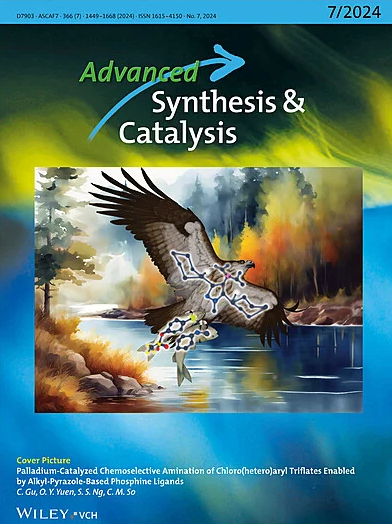Visible-Light-Induced Controlled C–H Cyanation or Thiocyanation of Indolizines
IF 4
2区 化学
Q2 CHEMISTRY, APPLIED
引用次数: 0
Abstract
An efficient and controlled approach for C–H cyanation/thiocyanation of indolizines is reported under visible-light-induced conditions. NH4SCN is used as the cyano or thiocyano source and the presence or absence of H2O2 are found to be the key factor in the selective construction of C-3 cyano or thiocyano indolizines. A set of control experiments, such as radical trapping experiments and fluorescence quenching studies are conducted to assess mechanistic insights of the reaction.

可见光诱导的受控碳-氢氰化或硫氰化
报道了一种在可见光诱导条件下高效、可控的吲哚嘧啶氰化/硫氰化方法。采用NH4SCN作为氰基或硫氰基源,发现H2O2的存在与否是C-3氰基或硫氰基吲哚嘧啶选择性构建的关键因素。一组对照实验,如自由基捕获实验和荧光猝灭研究进行了评估机理的见解。
本文章由计算机程序翻译,如有差异,请以英文原文为准。
求助全文
约1分钟内获得全文
求助全文
来源期刊

Advanced Synthesis & Catalysis
化学-应用化学
CiteScore
9.40
自引率
7.40%
发文量
447
审稿时长
1.8 months
期刊介绍:
Advanced Synthesis & Catalysis (ASC) is the leading primary journal in organic, organometallic, and applied chemistry.
The high impact of ASC can be attributed to the unique focus of the journal, which publishes exciting new results from academic and industrial labs on efficient, practical, and environmentally friendly organic synthesis. While homogeneous, heterogeneous, organic, and enzyme catalysis are key technologies to achieve green synthesis, significant contributions to the same goal by synthesis design, reaction techniques, flow chemistry, and continuous processing, multiphase catalysis, green solvents, catalyst immobilization, and recycling, separation science, and process development are also featured in ASC. The Aims and Scope can be found in the Notice to Authors or on the first page of the table of contents in every issue.
 求助内容:
求助内容: 应助结果提醒方式:
应助结果提醒方式:


